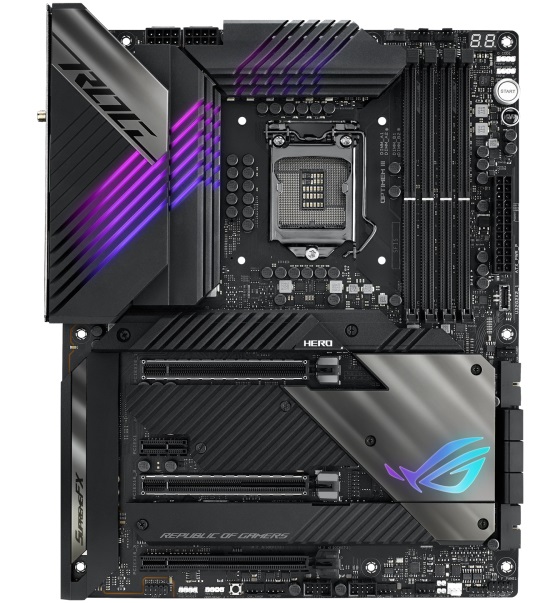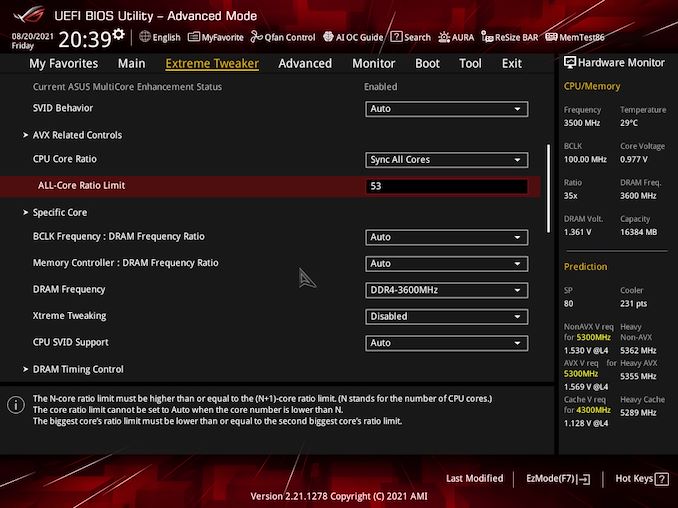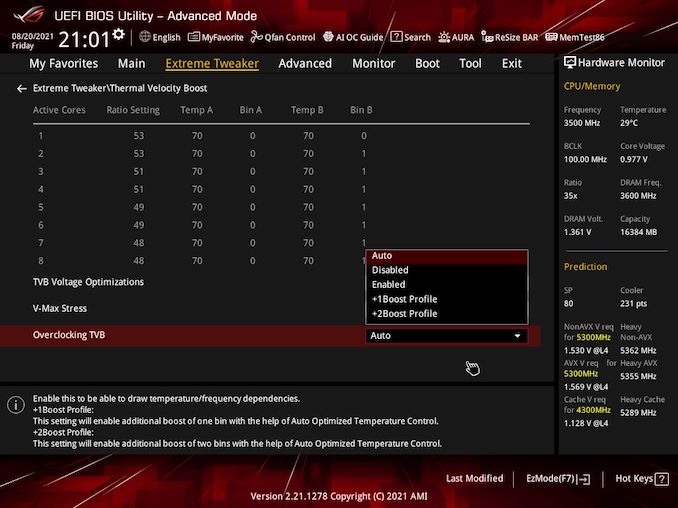Multi-chip Intel Core i9-11900K Overclocking Review: Four Boards, Cryo Cooling
by Gavin Bonshor on August 30, 2021 9:00 AM ESTThe ASUS ROG Maximus XIII Hero: A Quick Recap
Click here for the full review
The ASUS ROG Maximus XIII Hero is one of ASUS's most premium desktop models for Intel's Rocket Lake processors. Some of its features are shared on the more expensive flagship Z590 models. The aesthetic is clean throughout, and ASUS includes integrated RGB LED lighting in multiple areas. This complements the black and silver design throughout rather well. Looking at the Hero's core features, ASUS includes three full-length PCIe slots, with the top two operating at PCIe 4.0 x16 and x8/x8, while the third slot is electronically locked to PCIe 3.0 x4. In between the top to slots, ASUS also includes a single PCIe 3.0 x1 slot. Focusing on memory support, the Hero can accommodate up to 128 GB across four slots, including support for speeds of up to DDR4-5333 out of the box.
For storage, the Maximus XIII Hero includes for M.2 slots in total, including one PCIe 4.0 x4 M.2 slot, one with support for PCIe 3.0 x4 drives, and two with support for both PCIe 3.0 x4 and SATA drives. Other storage options include six SATA ports supporting RAID 0, 1, 5, and 10 arrays. The Hero boasts an impressive selection of controllers, including Thunderbolt 4, which adds two Type-C ports to the rear panel, as well as dual Intel I225-V 2.5 GbE controllers and Intel's latest AX210 Wi-Fi 6E CNVi. Like other models in the same market segment, it includes premium onboard audio, consisting of a ROG SupremeFX ALC4082 HD audio codec and an ESS Sabre ES9018Q2C DAC.
ASUS ROG Maximus XIII Hero Key Overclocking Variables
Some of the main variables to consider on the ASUS ROG Maximus XIII Hero when it comes to overclocking include:
- Premium 16-phase power delivery operating at 7+1 (teamed design)
- 2 x 8-pin 12 V ATX CPU power inputs
- Solid passive VRM cooling design
- Support for DDR4-5333 out of the box
Examining the 16-phase power delivery on the Hero more closely, it uses an Intersil ISL69269 PWM controller, operating in a 7+1 configuration but no doubles with ASUS' teamed mode. For the CPU section, ASUS uses fourteen Texas Instruments 9540RR 90 A power stages in teamed mode, making it a 7-phase CPU VRM design. The SoC section uses two Texas Instruments 59880 70 A power stages, which also uses teaming.

The 16-phase power delivery on the ASUS ROG Maximus XIII Hero (operating at 7+1)
The Hero is using a passively cooled power delivery design. Keeping the power delivery cool is a large two-part heatsink connected to the large rear panel cover on the board. It's very weighty and has plenty of mass to it.
ASUS ROG Maximus XIII Hero Firmware for Overclocking: Extreme Tweaker
The ASUS firmware across its Z590 range is consistent in layout, with subtle differences in GUI across each of the different series in the lineup. All of the board's overclocking options can be found within the Extreme Tweaker section of the Advanced area of the BIOS.
Within the Extreme Tweaker section, there's plenty of options for users to overclock all the main elements of the processor, memory, and integrated graphics. There are many variables to consider when performing extreme tweaks and for users looking to maximize efficiency. Still, the main options for overclocking the CPU are the CPU Core Ratio and CPU VCore voltage settings. Adjusting both of these options are the basic fundamentals of getting the most out of a processor.
For overclocking memory, ASUS allows users to enable X.M.P 2.0 profiles on compatible memory kits and provide extensive options for users looking to tweak latency timings and push the memory frequency.
The ASUS ROG firmware also allows users to overclock individual cores on the installed processor, with some more aggressive Intel Thermal Velocity Boost profiles. It should be noted that to make the most out of these profiles, more aggressive forms of cooling will be required, such as premium AIO's or custom water cooling.
ASUS is typically good with its ROG models for overclocking, and the varied amount of options available, including CPU frequency, voltage, power options, and memory settings, make this a solid option for users looking to maximize performance with Rocket lake.
When using the ASUS ROG Maximus XIII Hero to overclock each of the four Core i9-11900K's, we achieved the following stable all-core overclocks:
| Achieved Stable Overclock on Each Core i9-11900K | ||
| Intel Core i9-11900K Sample | Achieved All-Core CPU Frequency |
Achieved CPU VCore Voltage (V) |
| Chip #1 - Batch V051F933 | 5.2 GHz | 1.430 V |
| Chip #2 - Batch V051F933 | 5.2 GHz | 1.450 V |
| Chip #3 - Batch V051F933 | 5.2 GHz | 1.470 V |
| Chip #4 - Batch X101J374 | 5.1 GHz | 1.410 V |
From our testing on the ASUS ROG Maximus XIII Hero, three of our four Core i9-11900K's managed 5.2 GHz all-cores stable throughout our testing. The only one that didn't was the chip from the odd batch, which managed to achieve 5.1 GHz all-cores with a CPU VCore of 1.410 V. Despite our best efforts, chip #4 wasn't stable at 5.2 GHz all-cores even with voltages up to and including 1.50 V. On the ASUS board, our motherboard testbed chip is actually the best performer of the four chips, with 5.2 GHz all-cores at a modest 1.430 V on the CPU VCore.
In our VRM thermal testing during our full review of the board, we got the following results with the ASUS ROG Maximus XIII Hero with Chip #1 at 5.1 GHz with 1.450 V:
- VRM Sensor Temp: 55°C
- VRM Probe 1: 52°C
- VRM Probe 2: 54°C
- Ambient Temp: 23°C
During our review of the ASUS ROG Maximus XIII Hero and specifically in our VRM thermal testing, the Hero displayed some of the best VRM thermals we've seen from a Z590 motherboard. The design is a passive one, but it handled our predefined load very well, and we have no doubt that the credit should go to the design team at ASUS for this one.













54 Comments
View All Comments
StevoLincolnite - Monday, August 30, 2021 - link
I just upgraded from my 10~ year old Core i7 3930K Sandy Bridge CPU, 6-cores, 12 threads. Overclocked to 4.6Ghz with 16Gb of Quad-Channel Ram...Haven't noticed much of a difference when upgrading to the Ryzen 9 5900X and 64GB of 3600Mhz Ram in the games I play. (Mostly just eSports titles)
But hoping this rig lasts 10~ years like my last one.
Sold my old system in parts and so far made about $1,000 AUD back, which is definitely a good return on investment... Enough to buy a Radeon RX 6700XT.
lemurbutton - Monday, August 30, 2021 - link
Buy Apple Silicon. Pretty soon, no amount of energy-wasting, environmentally unfriendly overclocks can match the speed of a 35w Apple Silicon thin and light Macbook Pro.TheinsanegamerN - Monday, August 30, 2021 - link
> suggesting an apple ARM device for the enviroment.My sides have entered hyperspace. How can one be so dense?
bigvlada - Monday, August 30, 2021 - link
That's what we were hearing about slow and melting Pentium 66 MHz and lightning fast and cool 90 MHz PowerMac.And no, "This time it will be different tm" won't work, because just like in 1984. and 1994. majority of people do not want a closed, barely repairable system. In those early days, you needed a bayonet sized screwdriver and soldering iron in order to expand memory on Apple machines.
joelypolly - Monday, August 30, 2021 - link
I mean... look at the smartphone market. It's a good indication that the market has changed and most people are just looking for a computing appliance.M O B - Monday, August 30, 2021 - link
Oh really. Do people normally want to swap out the GPU, RAM, disk, or WiFi/BT card in their android phone? Of course now. Phones, despite their computational power, are not computers. You fail at analogy.Every company except Apple at least makes it possible to swap out several components, granted that soldered RAM or PCIe SSDs are common in certain compact form factors.
vshade - Tuesday, August 31, 2021 - link
Smartphones are computers for most of the world, is the device they will communicate, make planning and game on.whatthe123 - Monday, August 30, 2021 - link
It's an indication of an entirely new premium market that relies on subscriptions to mask costs. Macs continue to dominate in profitability but they always trail in marketshare because the upfront costs are too high, and nobody can really even get that market except Apple since Apple is the only one that has successfully created and maintained a lifestyle culture around their products. In order for Apple's CPUs to sweep the rest of the market they'd need to sell their chips directly or macs would need to overtake everything else in volume, neither of which Apple seems interested in doing or is really able to do since they're capped by TSMC's output.Exotic - Tuesday, August 31, 2021 - link
On Desktop I agree as people generally want easy upgradability. Where Apple Sillicon will shine and be very impressive to a lot people will be in laptops. In 99.99% of laptops the CPU and GPU is soldered and is not user upgradeable and the same is to said for ultrabooks regarding RAM as that too is getting soldered onto the mainboard.Laptops also sell more than desktops these days.
Wrs - Tuesday, August 31, 2021 - link
Being closed and barely repairable is a side effect of tight integration, not necessarily with being Apple. It is true that Apple tends to be associated with pushing the curve on engineering/miniaturization and naturally this results in a higher price, but they don't have a monopoly on integration and neither does the PC side have a monopoly on expansion and the use of commodity parts.I remember Macs from the 90s, as well as Mac Minis in the 2010s that incorporated tool less entry to the RAM slots, and with just a few regular screws you can access the same on Intel iMacs. Hard drives were just more screws. That's leaving aside the Mac Pro lineup. Yet no modern smartphone lets you upgrade the RAM or internal storage because it takes a lot more effort to design user serviceability into such a tiny yet functional form factor.